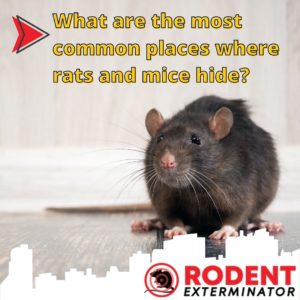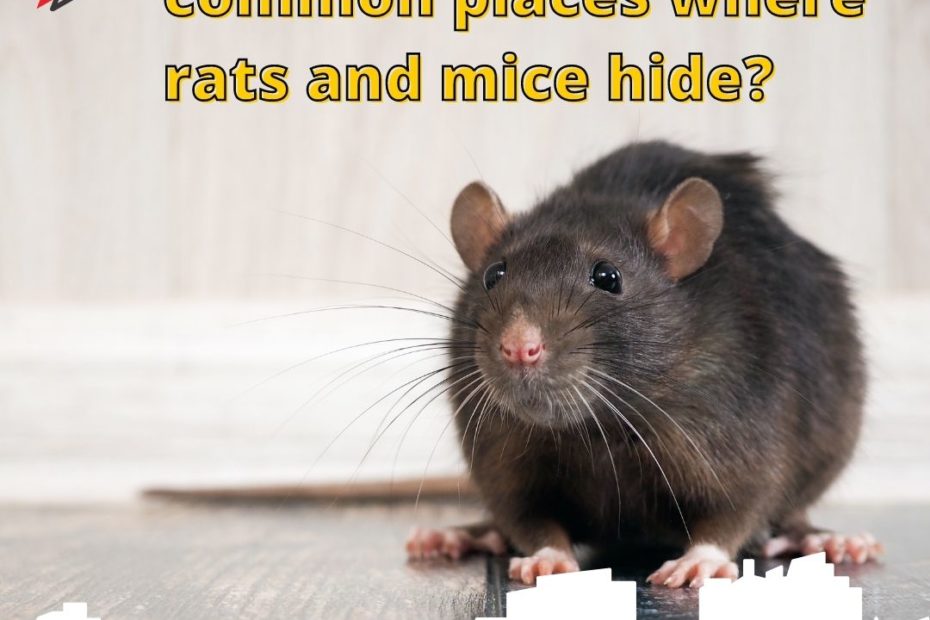An infestation of rodents is more than simply a nuisance. Rodents spread diseases and attract other pests, such as fleas and ticks, which pose a health risk to your family. Their proclivity for chewing on electrical wiring has resulted in numerous house fires.
Rats and mice at least, cause property damage and a tremendous mess.
Rodents seek out calm hiding areas that provide refuge from larger creatures. The warmth and safety of your house make it perfect for making nests.
Before foraging for food and nesting supplies, these nocturnal critters wait for the house to settle down.
Rats and mice like to take up residence in dark, hidden places. This can make it difficult to get rid of them, as they can be well hidden from view.
Some of the most common places where rats and mice hide are in attics, basements, behind walls and in crawl spaces.
If you’re having a problem with rodents, be sure to check all of these places for signs of infestation.

Where do rodents prefer to hide?
Here we discuss the favorite and most common places that rodents prefer to hide in your house:
-
Attics
Mice and roof rats are adept at locating access spots near roofs and eaves, and they can flatten their bodies to fit through minuscule openings.
They are pretty easy to hear from above, particularly in the evening.
Make sure the roof’s woodwork is in good shape, and that vents and chimneys are protected with sturdy wire mesh.
-
Inside the walls.
Rats and mice use wall cavities to get unrestricted access to the entire house. If a rodent falls from the attic, it may be unable to find a way out.
Listen for rustling and squeaking, then look for cracks in your baseboards. An unpleasant odor that lingers could suggest the presence of a decomposing body.
Contact Rodent Exterminator to help you locate contaminated in your house with the best professional exterminators in all of Los Angeles! Call us 213-431-0890
-
Basements, garages, storage closets, and sheds.
It’s no surprise that environments with minimal human traffic and a lot of clutter are appealing. They’re usually dark and silent, with lots of supplies for constructing a home.
Plastic storage boxes that haven’t been opened in a long time are as appealing as they come.
Maintain a clean and well-lit environment in these locations. If you’re storing pet food, choose robust plastic storage tubs with tight-fitting covers.
-
Kitchens
The kitchen is the exception to the rule of rats and mice nesting in often inhabited rooms. Rodent real estate is heavily marketed based on its proximity to food sources.
Mice like to hide beneath appliances, which provide them with a safe haven. They also find their way beneath sagging baseboards and under rarely used cupboards.
Keep your kitchen as tidy and crumbs-free as possible, and keep all food goods properly sealed.
However, rats and mice can also hide in:
- Air ducts.
- Venting systems.
- Behind cabinets and stoves.
- Under refrigerators.
- Inside wood piles.
- In piles of clutter.
Where do rats and mice hide during the day?
During the day, rats and mice will usually hide in areas that are dark and secluded. This can include places like attics, basements, crawlspaces, and behind walls.
They may also hide under furniture or in spaces between the flooring and the legs of furniture.
Rats and mice are attracted to the warmth of electrical cords, so be sure to check those areas as well.
Rodents like to hide in places where there is minimal foot traffic. They also hide in warm holes or cabinets near food, such as under appliances or in warm crevices.
Mouse and rat can hide under any debris or wreckage, such as stacks of cartons in the garage.
Remember to keep an eye on the walls and corners! You may find entry holes where they can nest or hide.
How do you find a hidden rat or mouse in your house?
When rodents are hiding in your home, it might be difficult to notice their presence. Here are some warning indicators to look out for:
- Strange noises, such as squeaking, scurrying, and running noises, can be heard in the walls.
- Piles of feces in obscure locations, such as behind the stove, in the basement or attic, or the home’s corners
- Bite marks on food packages, containers, or leftovers
- Smudges on the walls that appear to be a mix of dirt and grease
- Insulated nests, shredded paper, fabric scraps, and other soft materials
- The ducting that appears to have been gnawed on or otherwise damaged
If you’re still having trouble finding rodents in your house, you may want to consider calling a professional pest control company. They will be able to get rid of the rodents for you and help to prevent them from coming back.
How do you get a rat or mouse to come out of hiding?
It requires skill to catch a mouse. They’re not only nocturnal, but they’re also afraid of humans, so they’ll only come out after everyone is completely sleeping.
Furthermore, they prefer to live between walls and in other difficult-to-reach areas such as below cabinets and in the attic.
Even if you do manage to discover one of these little rodents, they’re quite fast, so they’ll most likely be gone before you can even consider trapping one.
We’ve put together a list of efficient and compassionate ways to entice a mouse out of hiding.
-
Place cheese-baited mouse traps throughout your home.
Although cheese is an old favorite, you don’t have to use it to entice rodents out of their hiding places.
Other things that can be used include fresh fruit and vegetables, nuts, berries, and even bread.
-
Use glue mouse traps
Use caution when dealing with these. Make sure glue traps aren’t placed in places where you or your family members might step on them by accident.
The adhesive is extremely sticky, and getting it on your skin or clothing can be deadly.
-
Poisons.
Mouse poisons are produced with components that are specifically designed to tempt mice. The mouse will die if it swallows the poison.
Many people favor more humane mouse control measures, although mouse poisons are quite effective if you don’t mind the end consequence.
-
Sprinkling different powerful smells around your home.
This may entice the rodents to come out of hiding and lead them in the direction you desire. You can drive mice out of their hiding spots by utilizing various scented products about the house.
Scents like peppermint, ammonia, onion, garlic , and alcohol repel mice and may tempt them to leave their haven in pursuit of a better smelling environment.
In conclusion, the most common places where rats and mice hide are in attics, basements, crawlspaces, behind walls.
Rats and mice will also hide under furniture or spaces between the flooring and the legs of furniture. Keep an eye out for signs of infestation around electrical cords too!
If you’re still having trouble getting rid of rodents from your home there are a few things that can be done to help prevent them from coming back.
Make sure to call a professional pest control company if all else fails!

